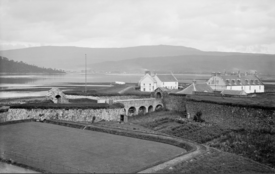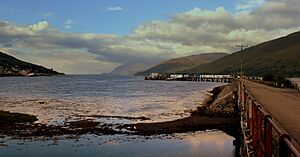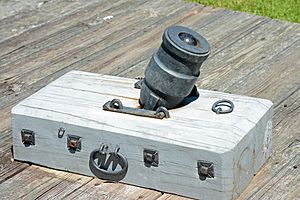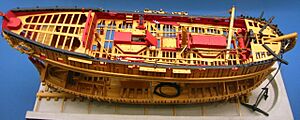Siege of Fort William facts for kids
Quick facts for kids Siege of Fort William |
|||||||
|---|---|---|---|---|---|---|---|
| Part of the Jacobite rising of 1745 | |||||||
 Photo taken by Erskine Beveridge in 1883 of the old fort at Fort William, Scotland, before it was demolished |
|||||||
|
|||||||
| Belligerents | |||||||
| Commanders and leaders | |||||||
| Strength | |||||||
| 400 | Estimated 1,000 | ||||||
The siege of Fort William was a military event that happened in the Scottish Highlands. It took place during the Jacobite Rising of 1745. The siege lasted from March 20 to April 3, 1746.
In February 1746, the Jacobites stopped trying to capture Stirling Castle. They moved to Inverness to wait for spring. During this time, they tried to take over government strongholds in the Highlands. These included Blair Castle and Fort Augustus. After Fort Augustus was captured on March 1, they moved towards Fort William.
The first Jacobite soldiers arrived near Fort William on March 8. The main attack began on March 20, but they did not make much progress. When the Duke of Cumberland and his army left Aberdeen in early April, the Jacobites were called back to Inverness. This meant they had to give up the siege.
Contents
What Was the Background of the Siege?
After the Jacobite Rising of 1715, a series of forts were built. These forts were located along what is now the Caledonian Canal. The most important ones were Fort George, Inverness, Fort Augustus, and Fort William. When the 1745 Rising started, more soldiers were sent to these forts. However, the forts themselves had not been well-maintained.
It was not until the Jacobites left Stirling Castle in February 1746 that they seriously tried to capture these forts. The capture of Fort Augustus on March 1 meant Fort William was the last government fort in the Great Glen.
On March 5, an engineer named Russell checked Fort William's defenses. He made some improvements and said the fort should be easy to hold. The fort's leader, Alexander Campbell, was replaced on March 15, 1746. Captain Caroline Frederick Scott took over command.
The fort had about 400 soldiers. It was a strong, modern fort shaped like a triangle. This shape used Loch Linnhe for protection. The fort had many cannons and mortars. Two ships, the Baltimore and the Serpent, also provided extra firepower. This made Fort William a very difficult target to attack. Its only weakness was not having a permanent water supply inside.
On February 25, 1746, the soldiers in the fort started tearing down buildings. These buildings were in the nearby village of Maryburgh. This cleared the area around the fort, making it harder for attackers to hide. However, they could not stop the Jacobites from taking over the hills around the fort. The Jacobite force included 150 French soldiers. They were led by Colonel Stapleton. There were also Scottish clansmen led by Lochiel and MacDonald of Keppoch.
How Did the Siege Unfold?
The Jacobites tried to block Loch Linnhe at the Corran Narrows. They captured one of the Baltimore's boats. This threatened to cut off the fort from outside help. Alexander Campbell quickly sent three boats with 71 men to the Narrows on March 4. They surprised the Jacobite guards, killing some and burning their houses and boats.
Local militia under Argyll destroyed property and farm animals nearby. This stopped supplies from reaching the Jacobites. It also put pressure on the Cameron and MacDonald clansmen to protect their lands. Lochiel and Keppoch wrote to Prince Charles. They asked him to allow them to get revenge on Clan Campbell. They even promised to hang one Campbell for every house destroyed.
Fort William was a strong, well-designed fort. Unlike Fort Augustus, it was hard to capture. The British controlled the sea, so the fort could easily get more supplies. The ships Serpent and Baltimore gave the fort more firepower than the attackers had. Colonel Stapleton thought the fort was too strong for the Jacobites to take. Prince Charles and his Scottish commander, Lord George Murray, agreed. However, Lochiel and Keppoch insisted on attacking. They wanted to stop the damage being done to their lands by the fort's soldiers.
Stapleton arrived outside the fort on March 8 with the French soldiers. Captain Scott arrived on March 15 aboard the Serpent. The fort's soldiers began firing at the Jacobites as they built their gun positions. An engineer named Grant was injured. He was replaced by Mirabel de Gordon. His work at Stirling was so bad that some people thought he had been paid off.
The Jacobites started firing on March 20. But bad roads and a lack of horses meant their heavy guns stayed in Inverness. The lighter guns and mortars they had did little damage to the fort's walls.
On March 22, the fort was asked to surrender. This was a common practice in wars back then. Captain Scott refused, saying he would defend the fort to the very end. It became clear that the Jacobite gun positions were not in good places. A new position had to be built higher up on Cow Hill. The fort's own cannons were effective. Clear, moonlit nights also made it hard for the Jacobites to get close without being seen. The only time for fighting was when soldiers left the fort to get water.
Like at Stirling and Carlisle, the Highlanders were not good at long sieges. The Baltimore ship continued to land raiding parties along the loch. The clansmen became frustrated because they could not protect their lands. This led to arguments between the Camerons and MacDonalds, and also with the French troops. The French soldiers did most of the building work.
On March 27, a new battery of four cannons opened fire. These guns were above the Governor's garden. The fort's outer walls were very strong. So, the Jacobites changed their plan to try and make the inside of the fort impossible to live in. On March 28, cannons on the eastern side fired heated cannonballs. They also fired grapeshot, old nails, and hot pieces of iron. These were meant to get stuck in the fort's wooden parts.
This caused a lot of damage to the fort's roof and upper parts. But the main fort itself was mostly unharmed. On the night of March 31, Scott sent 150 men out to destroy the Jacobite gun position. They timed their attack when the guards were changing. This left the position unprotected. The attackers captured or disabled four mortars and four cannons. They then attacked the battery above the Governor's garden. But this time, they were seen and pushed back. More soldiers from the fort arrived, and the attacking party returned safely. About eleven or twelve soldiers were hurt on each side.
After two weeks, the siege had not made much progress. With Cumberland's army getting ready to leave Aberdeen, Prince Charles needed all his soldiers. The Jacobites were ordered back to Inverness. They could only take what they could easily carry. On April 3, the fort's soldiers found that the Jacobites had left. They left their guns and heavy equipment behind.
What Happened After the Siege?
After the siege, the ships Baltimore and Terror were used to stop French supply ships. They also prevented clansmen in the Western Highlands and Islands from joining the main Jacobite army. After the Battle of Culloden, Scott searched for Prince Charles. He became known for being very harsh. Most of the stories about him are not confirmed by witnesses. However, he did seem to dislike Highlanders. He later moved to the East India Company in 1752. He died of a fever in Calcutta (modern Kolkata).
After the Rising, some changes were made to the fort's defenses. A moat was added on the land side. The fort's walls were also made stronger. The fort had soldiers until 1854. Its main job was to stop smugglers. It was officially closed in 1864 and sold to the West Highland Railway.
Images for kids







